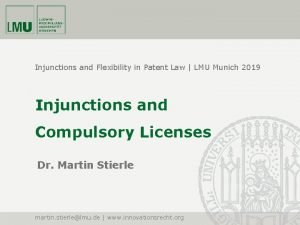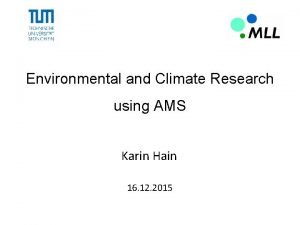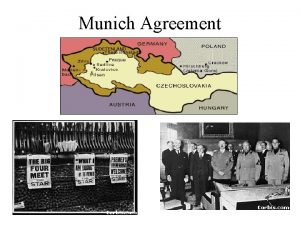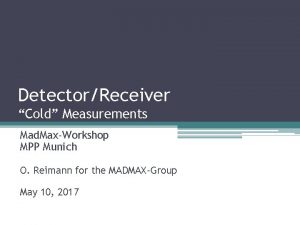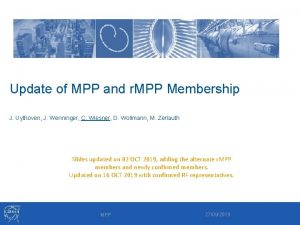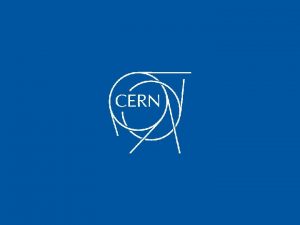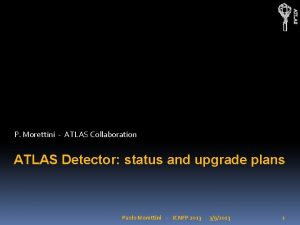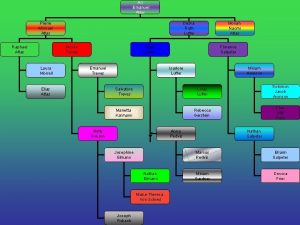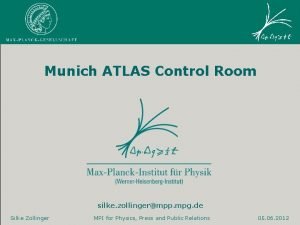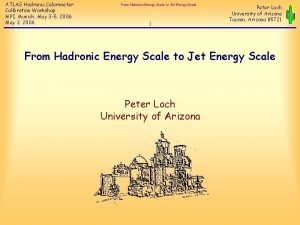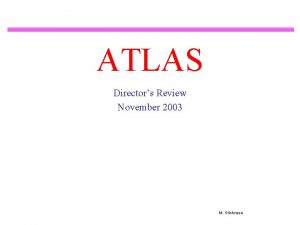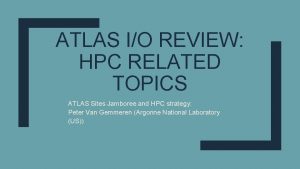MPP Project Review 2015 MPP ATLAS group Munich























- Slides: 23

MPP Project Review 2015 MPP ATLAS group Munich, December 14 th, 2015 Standard Model Physics at ATLAS G. Cortiana q Top quark mass measurements q WW cross section analysis strategy q Topological calorimeter clusters and their calibration q Prospects and conclusions

MPP ATLAS group Director: S. Bethke Senior scientists (10): T. Barillari, A. Kiryunin, S. Kluth, O. Kortner, S. Kortner, H. Kroha, S. Menke, R. Nisius, D. Salihagic, S. Stonjek Emeriti (4): H. Oberlack, R. Richter, P. Schacht, H. von der Schmitt Post docs (14): G. Compostella, G. Cortiana, C. Delle Fratte, M. Flowerdew, C. Giuliani, T. Ince, A. La Rosa, A. Macchiolo, F. Müller, M. Nagel, P. Schwegler, , F. Sforza, E. Takasugi, A. Wildauer Ph. D (12): K. Ecker, M. Goblirsch-Kolb, N. Köhler, D. Krauss, A. Maier, S. Nowak, R. Röhrig, N. Savic, K. Schmidt-Sommerfeld, , F. Spettel, S. Terzo, G. Wichmann Master (6): E. Fons, P. Gadow, J. Junggeburth, S. Maschekl, , V. Walbrecht, I. Weimer Bachelor (8): S. Annies, J. Corella Puertas, D. Joseph, D. Kresse, D. Nebe, M. Rendel, L. Schlechter, C. Schmid ATLAS wide responsibilities: S. Kluth: ATLAS software quality coordinator O. Kortner: Deputy muon project leader A. Macchiolo: ATLAS pixel sensor upgrade co-coordinator S. Menke: in 2015: ATLAS liquid argon electronics upgrade co-coordinator 24 ATLAS publications (14 in peer-reviewed journals)

First √s = 13 Te. V results (see Oliver’s talk for LHC performance in 2015) covered in this talk Goals: High precision measurements complementing direct searches for new physics (NP) Needs: Ultimate detector calibration / data understanding Long term projects still using 2011 /2012 datasets (√s=7 and 8 Te. V) LHC Run-2 highlights at ATLAS and CMS EOYE (Dec 15 th, 15: 00) G. Cortiana 3

Introduction: top quark top-quark pair production: ( ) dominant at the Tevatron √s = 1. 8 – 1. 96 Te. V dominant at the LHC √s ≥ 7 Te. V top-quark decays Experimental signatures are classified according to the W boson decay modes MPP analysis activities cover all final states and deliver precision measurements of the top quark mass Stringent tests of the SM and its extensions Important implication for the EW vacuum stability G. Cortiana 4

Analysis techniques: the template method observed objects Estimator sensitive to mtop Lepton ETmiss Jet 1 Jet 2 Jet 3 Eur. Phys. J. C 75 (2015) 330 example: lepton+jets final state can be obtained from a kinematic best fit to the decay hypothesis, considering all jet permutations and taking into account physics object resolutions Jet 4 Template method: the data distribution of a given mtop estimator (i. e. mtopreco) is fitted to the sum of signal and background PDFs (probability distribution functions) G. Cortiana 5

The problem… and its solution Observables’ main dependences mtop JES b. JES Reco mtop Good sensitivity to the underlying top quark mass. The quantity to be measured Large dependence on the jet energy scale Large systematics Large dependence on the b-jet energy scale Large systematics The uncertainties on the jet energy scale (JES) are O(few %) and vary with jet properties, flavor and event topology G. Cortiana 6

The problem… and its solution 2 -dim fits for mtop, JSF Observables’ main dependences mtop JES b. JES Reco mtop Reco m. W in the l+jets channel, the lightquark jets from W-decay can be used to determine a global jet energy scale factor (JSF) constraining the light jets JES variations Pioneered by the CDF collaboration in Phys. Rev. D 73: 032003, 2006 G. Cortiana 7

The problem… and its solution 3 -dim fits for mtop, JSF, b. JSF Observables’ main dependences mtop JES b. JES Reco mtop Reco m. W Reco Rbq in the l+jets channel, the lightquark jets from W-decay can be used to determine a global jet energy scale factor (JSF) constraining the light jets JES variations similarly a variable sensitive to the relative b-to-light jet energy scale (b. JSF) can be used to constrain the b-jet JES variations (b. JES) The mtopreco, m. Wreco and Rbqreco templates are used in a 3 d fit to the data to determine mtop, JSF and b. JSF G. Cortiana 8

Dilepton final states Excellent S/B ratio Under-constrained event kinematics (two escaping n) Use the template method with the mlbreco observable as an estimator for mtop: exploiting a partial reconstruction of the event Eur. Phys. J. C 75 (2015) 330 mtop Reco mlb G. Cortiana 9

Dilepton final states Excellent S/B ratio Under-constrained event kinematics (two escaping n) Eur. Phys. J. C 75 (2015) 330 Use the template method with the mlbreco observable as an estimator for mtop: exploiting a partial reconstruction of the event same problem as for the l+jets final state: mtop JES b. JES Reco mlb No direct in-situ (b)JSF determination possible. No JSF/b. JSF transfer from l+jets analysis, to minimize correlations and maximize gain in the combination. G. Cortiana 10

The use of different techniques (e. g. 1 dim or 3 -dim templates) introduces anticorrelation effects on the observables used to measure mtop Size (and sign) of the mtop syst. unc. in the lepton+jets and dilepton channels: l+jets (1 -dim), fit for mtop only l+jets (3 -dim), fit for mtop, JSF, b. JSF overall syst. reduction (l+jets) de-correlation of the observables Eur. Phys. J. C 75 (2015) 330 very significant gain (28%) in the combination G. Cortiana 11

All-jets final states Poorer S/B ratio The R 3/2 observable, defined as mjjb/mjj, is used as for the 7 Te. V analysis (carried out at LMU) which yielded: it achieves a partial cancellation of the systematic effects common to mtopreco and m. Wreco Illustrative plot from the 7 Te. V analysis Eur. Phys. J. C 75 (2015) 158 Particular attention required to model the background via data-driven techniques Outlook: MPP is leading the efforts towards mtop analysis updates using the 8 Te. V dataset (x 4 more data allows trade-offs between statistical and systematic uncertainties) All analyses are well advanced All-jets: Ph. D thesis T. Mc. Carthy (Sept. 2015, Carleton University + MPP) Dilepton: Ph. D thesis A. Maier (end 2015) Lepton+jets: phase-space optimization ongoing Publications planned for 2016 (including their combination) G. Cortiana 12

(boosted) WW x-section measurement In addition to being the main background for H WW analyses, the WW production is sensitive to anomalous triple gauge boson couplings (a. TGCs), and to possible new particles decaying into vector bosons (see Claudia’s Higgs+NP talk) JHEP 01 (2015) 049 Increasingly important at higher √s and in boosted topologies Analysis strategy: Ph. D thesis: F. Spettel Master thesis: E. Fons One leptonically decaying W One hadronically decaying W (boosted) Illustrative plot from the 7 Te. V inclusive analysis Use fat-jets techniques based on jet sub -structure identification, as well as multivariate techniques to improve signal/background ratio G. Cortiana 13

Calorimeter topo-clusters and their calibration For all analyses described before, jet calibration (and its uncertainty) constitutes a critical input graphics by T. Mc. Carthy MPP developed and fully commissioned novel ideas for the clustering and calibration of calorimeter signals into topological clusters (topo-clusters) that are used in subsequent physics object reconstruction follow electromagnetic / hadronic shower development Topo-clusters grow around seeds according to noise dependent energy thresholds suppress noise and pile-up energy contributions (see also ar. Xiv: 1510. 03823) their features are used to classify and calibrate clusters ATLAS-CONF-2015 -037 Default for √s ≥ 8 Te. V analyses particularly important for E Tmiss and jet (sub-structures) calibration provides a reduced JES uncertainty (important for precision analyses) EM+JES calibration scheme ATLAS paper to appear soon G. Cortiana 14

Conclusions The MPP group is very active on high impact Standard Model measurements performed using ATLAS data it provides the most precise ATLAS mtop results and has a long history driving multiexperiment combination efforts (LHC and Tevatron+LHC). This will resume as soon as 8 Te. V results are published it is pursuing a WW -> lnjj production cross section measurement in the boosted regime, very sensitive to anomalous triple gauge boson coupling it delivers standards for the calorimeter energy measurements and calibrations vital for physics object reconstruction and precision measurements (successful hand-shake between physics analyses and detector performance studies) Papers / theses based on 8 Te. V datasets are in the pipeline … know-how and expertise ready to be applied to the 13 Te. V dataset Stay tuned! Thanks for your attention! G. Cortiana 15

– Backup –

2015 : LHC @ 13 Te. V April 7 th, 2015: Splash events May 5 th, 2015: first 900 Ge. V collisions (injection energy) May 21 st, 2015: first 13 Te. V collisions First Stable beams at 13 Te. V June 3 rd, 2015 First top quark pair candidate event at 13 Te. V June 4 th, 2015 G. Cortiana 17

LHC performance For comparison √s=8 Te. V <m>= 20. 7 √s=7 Te. V <m>= 9. 1 For comparison √s=8 Te. V 22. 8 (21. 3) fb-1 Del. (Rec. ) √s=7 Te. V 5. 46 (5. 08) fb-1 Del. (Rec. ) 2012 2011 2010 2015 Similar performance/conditions as for 2011 data, but with almost doubled √s! G. Cortiana 18

The top-quark mass JHEP 1208 (2012) 098 Higgs, top quark, and W boson masses are related A precise determination of mtop combined with EW precision measurements allows for stringent tests of the SM and its extensions Also interesting theoretically due to its possible Eur. Phys. J. C 74 (2014) 3046 cosmological implications: depending on the values of m. H and mtop, the Higgs quartic coupling could be rather small, vanish or even turn negative at a scale smaller than the Planck scale. This affects the shape of the SM Higgs potential: if the Higgs field is trapped in a local minimum during the early universe, it can cause inflation (requires a non-minimal Higgs coupling to gravity) G. Cortiana 19

On the mtop definition Pole mass = pole in the propagator but there are self-energy corrections: Renormalization schemes are defined by which quantum fluctuations are kept in the dynamical matrix elements and which ones are absorbed into the couplings and masses Different renormalization schemes yield different mass definitions m 0 and S’ is divergent. The choice of the renormalization scheme corresponds to a particular definition of the mass parameter dm can be used to absorb the divergencies e. g. : G. Cortiana 20

ar. Xiv: 1510. 04483 G. Cortiana 21

Calorimeter topo-clusters and their calibration For all analyses described before, jet calibration (and its uncertainty) constitutes a critical input snoise (2012 pile-up conditions) ar. Xiv: 1510. 03823 MPP developed and fully commissioned novel ideas for the clustering and calibration of calorimeter signals into topological clusters (topoclusters) that are used in subsequent physics object reconstruction follow electromagnetic (EM) / hadronic (HAD) shower development suppress noise and pile-up energy contributions (see also ar. Xiv: 1510. 03823) graphics by T. Mc. Carthy G. Cortiana 22

Local Hadron Calibration Eur. Phys. J. C 73 (2013) 2304 Topo-custer shapes and other features are used to classify EM-like/HAD-like cluster for proper MC based local calibration Default for √s≥ 8 Te. V analyses particularly important for -structures) calibration ETmiss and jet (sub ATLAS-CONF-2015 -037 in addition out-of-cluster and dead-material corrections are applied EM+JES calibration scheme provides a reduced JES uncertainty (important for precision analyses) ATLAS paper to appear soon G. Cortiana 23
 The courtyard of the old residency in munich
The courtyard of the old residency in munich Munich weather radar
Munich weather radar Munich germany currency
Munich germany currency Hitler knight
Hitler knight Why did the beer hall putsch fail
Why did the beer hall putsch fail Munich airport car parking
Munich airport car parking Molching munich
Molching munich Munich re nat cat service
Munich re nat cat service Autoportrait (dürer, munich)
Autoportrait (dürer, munich) Hotels oktoberfest munich
Hotels oktoberfest munich Sat to munich
Sat to munich What year was the treaty of versailles signed
What year was the treaty of versailles signed Peter mortimer munich
Peter mortimer munich Munich putsch sources
Munich putsch sources Lmu munich law
Lmu munich law Mll munich
Mll munich Bayern munich igraci
Bayern munich igraci Why was the munich conference unsuccessful
Why was the munich conference unsuccessful Mpp katedra
Mpp katedra Explain various boundary descriptors.
Explain various boundary descriptors. Azure sql data warehouse mpp
Azure sql data warehouse mpp Rumus mpp
Rumus mpp Xer to mpp
Xer to mpp Azure sql analytics
Azure sql analytics














